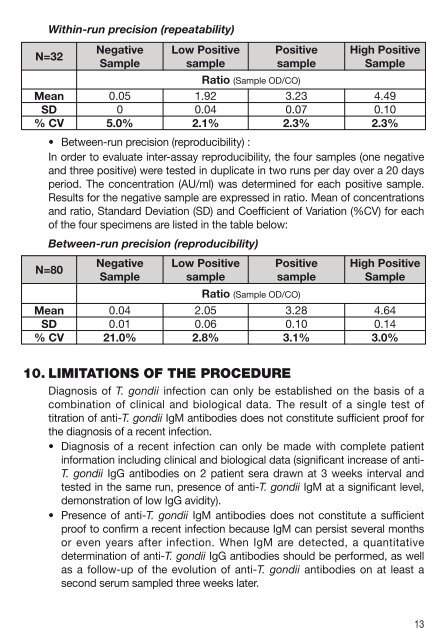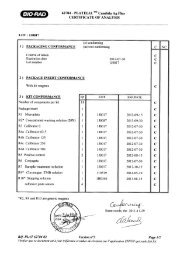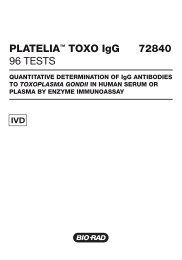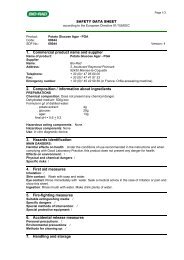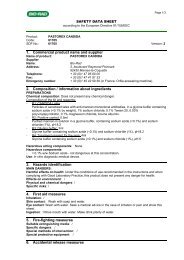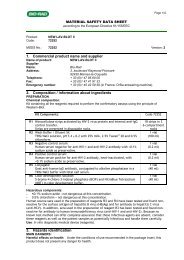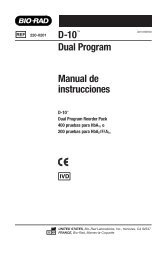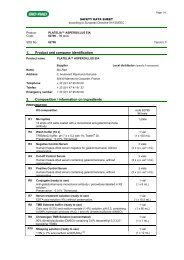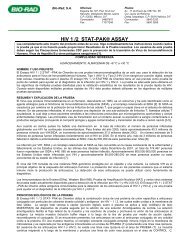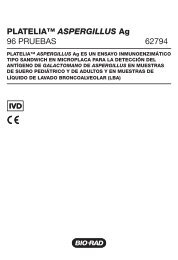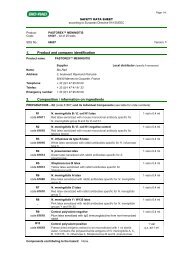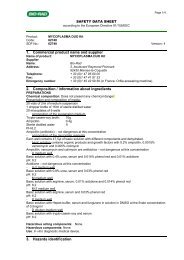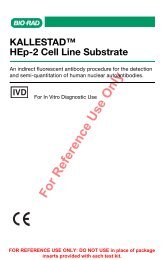72841-Platelia Toxo IgM.pdf - BIO-RAD
72841-Platelia Toxo IgM.pdf - BIO-RAD
72841-Platelia Toxo IgM.pdf - BIO-RAD
You also want an ePaper? Increase the reach of your titles
YUMPU automatically turns print PDFs into web optimized ePapers that Google loves.
Within-run precision (repeatability)<br />
N=32<br />
Negative<br />
Sample<br />
Low Positive<br />
sample<br />
Positive<br />
sample<br />
High Positive<br />
Sample<br />
Ratio (Sample OD/CO)<br />
Mean 0.05 1.92 3.23 4.49<br />
SD 0 0.04 0.07 0.10<br />
% CV 5.0% 2.1% 2.3% 2.3%<br />
• Between-run precision (reproducibility) :<br />
In order to evaluate inter-assay reproducibility, the four samples (one negative<br />
and three positive) were tested in duplicate in two runs per day over a 20 days<br />
period. The concentration (AU/ml) was determined for each positive sample.<br />
Results for the negative sample are expressed in ratio. Mean of concentrations<br />
and ratio, Standard Deviation (SD) and Coefficient of Variation (%CV) for each<br />
of the four specimens are listed in the table below:<br />
Between-run precision (reproducibility)<br />
N=80<br />
Negative<br />
Sample<br />
Low Positive<br />
sample<br />
Positive<br />
sample<br />
High Positive<br />
Sample<br />
Ratio (Sample OD/CO)<br />
Mean 0.04 2.05 3.28 4.64<br />
SD 0.01 0.06 0.10 0.14<br />
% CV 21.0% 2.8% 3.1% 3.0%<br />
10. LIMITATIONS OF THE PROCEDURE<br />
Diagnosis of T. gondii infection can only be established on the basis of a<br />
combination of clinical and biological data. The result of a single test of<br />
titration of anti-T. gondii <strong>IgM</strong> antibodies does not constitute sufficient proof for<br />
the diagnosis of a recent infection.<br />
• Diagnosis of a recent infection can only be made with complete patient<br />
information including clinical and biological data (significant increase of anti-<br />
T. gondii IgG antibodies on 2 patient sera drawn at 3 weeks interval and<br />
tested in the same run, presence of anti-T. gondii <strong>IgM</strong> at a significant level,<br />
demonstration of low IgG avidity).<br />
• Presence of anti-T. gondii <strong>IgM</strong> antibodies does not constitute a sufficient<br />
proof to confirm a recent infection because <strong>IgM</strong> can persist several months<br />
or even years after infection. When <strong>IgM</strong> are detected, a quantitative<br />
determination of anti-T. gondii IgG antibodies should be performed, as well<br />
as a follow-up of the evolution of anti-T. gondii antibodies on at least a<br />
second serum sampled three weeks later.<br />
13


